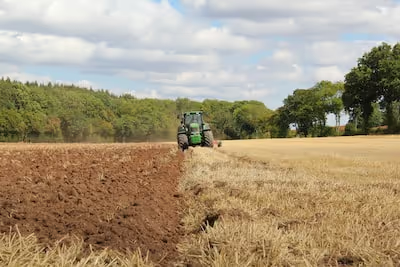Most Profitable Crops to Grow in Your Market Garden

most profitable crops
Planting the most profitable crops transforms a modest garden into a thriving side hustle. Herbs like basil and specialty greens such as arugula pack substantial profits into compact spaces, while microgreens promise rapid harvest cycles—often within two weeks. Selecting the most profitable crops starts with identifying local market demands, ensuring your gardening efforts translate into steady cash flow. Here's your ticket to cultivating abundance.
Cheatsheet: Power Crops for Quick Market Garden Profits
🌱 Best Crops for Selling Fast
- Microgreens: 7–21 days cycle; $20–$40/lb; rich in vitamins C, E, K.
- Baby Lettuce: 21–30 days; up to $10/lb; high turnover.
- Heirloom Tomatoes: $5–$12/lb; summer staple; gourmet demand.
- Salad Mixes: $5–$10/lb; mix for premium sales.
- Specialty Herbs (basil, cilantro): $16–$30/lb; chefs buy weekly.
- Cut Flowers: sunflowers, zinnias, ranunculus—$10–$30/bouquet.
- Garlic: $9–$15/lb; long storage, minimal inputs.
- Baby Carrots & Beets: Small, sweet, $3–$6/bunch, valued by chefs.
💡 Keys to Maximize Profits
- Succession planting stretches harvest window.
- Double-crop beds (e.g. lettuce ➔ radish).
- Direct sell to restaurants or at farmers’ markets.
- Focus on quick, high-value, perishable crops.
- Constant soil feeding (compost, fish emulsion).
- Harvest early for peak flavor, longer shelf life.
🛠️ Tools and Products You'll Need
- Landscape fabric or silage tarps for weed suppression
- Broadfork, flame weeder, sharp harvest knives
- Wash station setups: mesh crates, bins, drying racks
- Irrigation: drip line, timer, rain gauge
- Row cover (frost protection); shade cloth
- Cold storage or coolers for post-harvest
- Certified organic compost
- Quality seeds—source disease-resistant, local varieties
🚚 Fast Paths to Market
- Sell subscriptions/CSAs for weekly recurring revenue
- Pitch chefs: deliver fresh, unique, micro-batch crops
- Bundle herbs, greens, edible flowers for premium boxes
- Use social media for direct popup orders
🍽️ Nutrition & Self-Sufficiency Impact
- Microgreens deliver up to 40x more nutrients than mature plants.
- Leafy greens boost immunity and iron intake.
- Herbs supply antioxidants, support gut health.
- Produce high-quality food, reduce grocery bills, boost local resilience.
Step 1: Map your beds. Rotate crops to maximize harvests and prevent disease. Use succession schedules for continuous supply.
Step 2: Amend soil with compost, test pH (aim 6.0–7.0). Tarp/weigh down beds for two weeks before planting.
Step 3: Sow densely for fast-maturing crops. Use drip irrigation. Apply organic mulch or fabric to hold moisture.
Step 4: Harvest in cool mornings, handle gently. Wash, spin or dry greens quickly. Store at 33–38°F (0.5–3°C).
Step 5: Package attractively. Deliver same-day for optimal freshness. Build strong relationships with buyers.
Choosing the Right Crops for Profit
I remember clearly the summer I planted heirloom tomatoes—
By season's end, each tomato plant had brought in four times the investment I had made. Not bad for an afternoon spent in the dirt.
The most profitable crops have a few common traits: high market prices, steady demand, ease of growing, and efficient use of garden space. Below, I'll share a few of my personal favorites that never let me down.
1. Gourmet Mushrooms
Growing mushrooms taught me patience—and paid handsomely. Shiitakes, oysters, and lion's mane thrive indoors with minimal overhead.
- Fast-hearty harvests: Some species mature in as little as two weeks.
- High price-tag: Specialty mushrooms fetch premium prices at local markets and restaurants.
- Space efficiency: Vertical growing methods save valuable square footage.
The first oyster mushrooms I grew netted around $12 (€11) per pound (around 0.45 kg) at farmers' markets. Small investment, nice returns.
2. Herbs—Basil, Cilantro, and Lavender
There's a reason fresh herbs command top dollar. Culinary herbs like basil and cilantro offer quick turnover, while lavender appeals widely for its aromatic and cosmetic uses.
- Basil and Cilantro: Quick growers, ready for picking in about 4 weeks.
- Lavender: Long-term crop—demand for bunches, dried buds, and essential oils is consistently strong.
Last season, fresh-cut lavender bundles sold for $8 (€7.50) each at my local artisan market. Multiply that by a generous harvest, and you see the potential.
3. Salad Greens and Microgreens
Don’t underestimate these fresh, leafy players. Salad greens and microgreens deliver consistent demand because freshness matters in taste and nutrition.
- Rapid harvest: Microgreens sprout and are harvest-ready in roughly 14 days.
- High return per square foot: Efficiently maximize limited garden space.
- Repeat sales: Chefs, market shoppers, and health enthusiasts buy repeatedly.
My modest, 10-square-foot (around 0.9 square meters) microgreens patch consistently yields about $100 (€93) per week at farmers' markets. Impressive, right?
4. Garlic—The Unsung Hero
Garlic bulbs build wealth quietly underground. Low fuss to maintain, and when harvest arrives, buyers scramble for fresh, aromatic bulbs.
- Unfussy growing practices: Requires minimal care, thrives across diverse climates.
- Reliable, attractive margins: Organically grown garlic fetches $2 (€1.85) per bulb or higher.
Last October, my garlic patch brought in roughly $400 (€370) for minimal effort on a relatively small plot. Plant them in autumn; by summer, you've got bulbs worth their weight in culinary gold.
5. Specialty Peppers and Chiles
The hotter the pepper, often, the hotter the market. Exotic or fiery chiles—Carolina Reapers or shishito peppers—can spark significant interest and profit.
- Premium prices: Exotic peppers often sell individually or by weight at premium rates.
- Strong niche markets: Local chefs and foodies eagerly buy specialty peppers.
A batch of ghost peppers once earned me $25 (€23) per pound (about 0.45 kg), especially coveted by restaurants experimenting with spicy dishes.
Finding Your Balance
The most profitable crops balance ease of cultivation with market value. Each crop listed here met my high-standard: minimal headaches, maximal returns.
Remember, profitability in gardening isn't only about money—it's about growing smart and growing joyfully. Choose crops that excite and inspire you.
Invest thoughtfully in plants that promise the highest payoff—in finances, yes, but also in satisfaction, flavor, and proud smiles at harvest time.
Frequently Asked Questions About Cultivating High-Yield Crops
Which crops yield the highest returns per acre?
Crops that command premium prices at market include heirloom tomatoes, organic salad greens, gourmet mushrooms, and specialty herbs like lavender or basil. Selecting crops with shorter growing cycles or high market demand can significantly boost returns per cultivated acre.
How do soil conditions affect crop profitability?
The fertility and structure of your soil directly determine yield and crop quality. Rich, well-draining soils with ample organic matter encourage vigorous plant growth, reducing production costs and generating higher-quality harvests that attract better prices. Incorporating compost, conducting regular soil tests, and practicing crop rotation maintain optimal conditions.
Which crops have strong market demand with a short growing season?
Plants like microgreens, baby spinach, and fast-maturing herbs such as cilantro or arugula mature rapidly—often within 20–40 days—and consistently draw strong consumer demand at farmers' markets and upscale grocers.
Are specialty or heirloom varieties worth cultivating for profit?
Yes, specialty and heirloom varieties often command higher prices due to unique flavors, rarity, and consumer preference for quality over volume. However, these crops may require additional care, careful selection of planting sites, and targeted marketing strategies to reach their fullest profit potential.
Can small-scale growers profit from cultivating herbs and spices?
Absolutely. Herbs and spices, particularly rare or gourmet varieties like saffron, vanilla beans, or unique culinary herbs, typically fetch premium prices. Even small plots can generate substantial revenue, especially if you establish direct sales relationships with restaurants, specialty food retailers, or local markets.
Which crops offer high yield potential in limited growing space?
Crops suited to intensive cultivation, such as vertical-grown microgreens, specialty mushrooms, and compact herbs like chives or parsley, thrive in small growing areas. Efficient management and vertical growing techniques maximize square footage productivity, offering impressive returns from minimal available space.
How do climate and local weather conditions influence crop selection?
Temperature ranges, rainfall patterns, and growing seasons greatly determine which crops thrive in your region. For example, delicate herbs prefer consistent temperatures between 60–75°F (15–24°C), whereas cool-season greens perform best at 50–65°F (10–18°C). Aligning crop choices with local climatic conditions reduces risk, lowers costs, and drives profitability.
Chasing the most profitable crops isn’t about luck—it’s about knowing your soil, your market, and your strengths. Microgreens, specialty greens, heirloom tomatoes, and gourmet mushrooms can all put real money in your pocket if you play your cards right. Don’t overlook the quiet power of smart planning—tight successions, year-round production, and soil that’s fed well and often. Want bigger yields? Soil fertility is non-negotiable. And don’t be afraid to experiment—sometimes the weirdest crops make the best sellers at market. In the end, the most profitable crops are the ones that fit your plot, your hustle, and your local demand. Grow smart, sell smarter, and let the profits follow.
The Homesteader's Take on Profitable Market Crops
High-Yield Preservation Crops
- Heirloom tomatoes: Rich in antioxidants, ideal canned, sun-dried or as sauces; extend shelf life 8–12 months.
- Garlic and onions: Low-effort, year-round culinary staples; store in cool cellars up to 6–10 months without refrigeration.
- Winter squash: Vitamin-rich, versatile cooking staple; extended storage up to 4–6 months in dry, cool conditions (50°F/10°C).
Multi-Purpose Medicinals and Herbs
- Echinacea: Immune-supporting perennial; market dried roots or tinctures.
- Lemon balm and mint: Stress-relief teas; quick perennial propagation via cuttings generates rapid returns.
- Calendula: Skin-soothing flowers harvested fresh or dried; popular in home remedies and cosmetics.
Self-Sufficient Seed & Root Strategies
- Sweet potatoes: Fast producer of nutrient-dense tubers; propagate through vine cuttings for zero-cost starts.
- Dry beans and peas: Packed with plant protein; effortless long-term storage, multi-year seed saving potential.
Value-Added Homestead Crafts
- Dried culinary mushrooms: Shiitake, oyster mushrooms command premium prices when dried; shelf-stability extended to 12–24 months.
- Herbal vinegar and infused oils: Convert surplus herbs into high-margin, shelf-stable products; ready in 4–8 weeks.
Find out which plants will thrive in your garden!
Answer a few fun questions and get custom plant recommendations perfect for your space. Let’s grow something amazing together!

start your season





